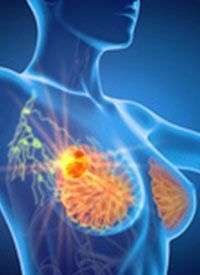Fluorouracil Is Inappropriate for Optimal Adjuvant Chemotherapy in High-Risk Early Breast Cancer
Updated results from the phase 3 GIM 2 study confirm previous findings showing that fluorouracil should not be a part of adjuvant chemotherapy for patients with high-risk early breast cancer.

Updated results from the phase 3 GIM 2 study (NCT00433420) confirm previous findings showing that fluorouracil should not be a part of adjuvant chemotherapy for patients with high-risk early breast cancer.1
From April 2003 to July 2006, investigators randomly assigned 2091 patients with ECOG 0 to 1 status operable, node-positive, breast cancer to 1 of 4 treatment groups:
- four cycles of standard-interval intravenous (IV) epirubicin 90 mg/m2 and cyclophosphamide 600 mg/m2(EC) on day 1 every 3 weeks, followed by 4 cycles of IV paclitaxel 175 mg/m2 on day 1 every 3 weeks (n = 545; q3EC-P)
- four cycles of IV fluorouracil 600 mg/m2, epirubicin 90 mg/m2, and cyclophosphamide 600 mg/m2 (FEC) on day 1 every 3 weeks, followed by 4 cycles of IV paclitaxel 175 mg/m2 on day 1 every 3 weeks (n = 544; q3FEC-P)
- the same doses and drugs as the q3EC-P group administered every 2 weeks (n = 502; q2EC-P)
- the dose-dense FEC-P regimen with the same doses and drugs as the q3FEC-P group administered every 2 weeks (n = 500; q2FEC-P)
Eighty-eight patients enrolled at centers providing only standard interval schedule and were assigned only to q3FEC-P or q3EC-P. As a result, 2091 patients were included in the intention-to-treat analysis for the comparison of EC-P (n = 1047) versus FEC-P (n = 1044). Investigators included 2003 patients in the intention-to-treat analysis for the comparison of dose-dense (n = 1002) vs standard interval analyses (n = 1001).
At a median follow-up of 15.1 years (interquartile range [IQR], 8.4-16.3), the median disease-free survival (DFS) was not significantly different between FEC-P (17.09 years; 95% CI, 15.51-not reached [NR] and EC-P groups (NR; 95% CI, 17.54-NR; unadjusted HR, 1.12, 95% CI, 0.98-1.29; log-rank P = .11). However, the median DFS was significantly higher in the dose-dense interval group (95% CI, 17.45-NR) compared with the standard-interval group (NR vs 16.52; 95% CI, 14.24-17.54; HR, 0.77; 95% CI, 0.67-0.89; P = .0004).
“Updated results from the GIM2 study support that optimal adjuvant chemotherapy for patients with high-risk early breast cancer should not include fluorouracil and should use a dose-dense schedule,” investigators wrote.
The most common grade 3/4 adverse effects (AEs) were neutropenia (37% in the q3EC-P group, 48% in the q3FEC-P group, 10% in q2EC-P group, and 20% in the q2FEC-P group) and alopecia (44%, 47%, 46%, and 48%, respectively). Investigators observed no new grade 3/4 AEs or deaths related to toxic effects during extended follow-up. Nine (2%) patients in the q3EC-P group, 7 (1%) in the q3FEC-P group, 9 (2%) in the q2EC-P group, and 9 (2%) in the q2FEC-P group reported serious treatment-related AEs. There were no treatment-related deaths.
Investigators released 7-year follow-up data from GIM 2 in 2015. DFS at 5 years was 81% (95% CI, 79%-84%) in patients treated every 2 weeks and 76% (95% CI, 74%-79%) in patients treated every 3 weeks (HR, 0.77, 95% CI, 0.65-0.92; P = .004). The 5-year overall survival (OS) rates were 94% (95% CI, 93%-96%) in the 2-week arms and 89% (95% CI, 87%-91%) in the 3-week arms (HR, 0.65; 95% CI, 0.51-0.84; P = .001).2
Five-year DFS was 78% (95% CI, 75%-81%) in the FEC-P groups and 79% (95% CI, 76%-82%) in the EC-P groups (HR, 1.06; 95% CI, 0.89-1.25; P = .561). The 5-year OS rates were 91% (95% CI, 89%-93%) and 92% (95% CI, 90%-94%), respectively (HR, 1.16; 95% CI, 0.91-1.46; P = .234).
Investigators found that compared with 3-week dosing, the 2-week dosing schedule was associated with increased rates of grade 3/4 anemia (0.2% vs 1.4%; P = .002), transaminitis (0.4% vs 1.9%; P = .001), and myalgias (1.6% vs 3.1%; P = .019). Two-week dosing was associated with decreased rates of grade 3/4 neutropenia (14.9% vs 44.0%; P <.0001).
The addition of fluorouracil led to increased rates of grade 3/4 neutropenia in patients in the FEC-P group compared with the EC-P group (34.5% vs 24.2%; P <.0001), fever (0.9% vs 0.2%), nausea (4.6% vs 2.7%), and vomiting (3.1% vs 1.4%).
References
- Del Mastro L, Poggio F, Blondeaux E, et al. Fluorouracil and dose-dense adjuvant chemotherapy in patients with early-stage breast cancer (GIM2): end-of-study results from a randomised, phase 3 trial. Lancet Oncol. Published online November 9, 2022. doi:10.1016/S1470-2045(22)00632-5
- Del Mastro L, De Placido S, Bruzzi P, et al. Fluorouracil and dose-dense chemotherapy in adjuvant treatment of patients with early-stage breast cancer: an open-label, 2 × 2 factorial, randomised phase 3 trial. Lancet. 2015;385(9980):1863-1872. doi:10.1016/S0140-6736(14)62048-1



